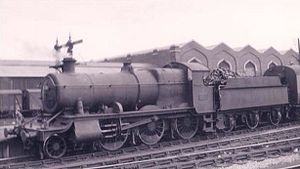GWR 4300 Class

6381 at Southampton Terminus 1949
|
|||||||||||||||||||||||||||||||||||||||||||||||||||
|
|||||||||||||||||||||||||||||||||||||||||||||||||||
|
|||||||||||||||||||||||||||||||||||||||||||||||||||
|
|||||||||||||||||||||||||||||||||||||||||||||||||||
|
|||||||||||||||||||||||||||||||||||||||||||||||||||
| Type and origin | |
|---|---|
| Power type | Steam |
| Builder |
|
| Build date | 1911–1932 |
| Total produced | 342 |
| Specifications | |
|---|---|
| Configuration: |
|
| • Whyte | 2-6-0 |
| • UIC | 1'C h |
| Gauge | 4 ft 8 1⁄2 in (1,435 mm) standard gauge |
| Leading dia. | 3 ft 2 in (0.965 m) |
| Driver dia. | 5 ft 8 in (1.727 m) |
| Minimum curve | 6 chains (400 ft; 120 m) normal, 5 chains (330 ft; 100 m) slow |
| Length | 58 ft 1 1⁄4 in (17.71 m) |
| Width | 8 ft 11 in (2.718 m) |
| Height | 13 ft 0 in (3.962 m) |
| Axle load | 17.60 long tons (17.88 t; 19.71 short tons) |
| Adhesive weight | 52 long tons 0 cwt (116,500 lb or 52.8 t) (52.8 t; 58.2 short tons) |
| Loco weight | 62 long tons 0 cwt (138,900 lb or 63 t) (63.0 t; 69.4 short tons) |
| Tender weight | 40 long tons 0 cwt (89,600 lb or 40.6 t) (40.6 t; 44.8 short tons) |
| Fuel capacity | 7 long tons 0 cwt (15,700 lb or 7.1 t) (7.1 t; 7.8 short tons) |
| Water cap | 3,500 imp gal (16,000 l; 4,200 US gal) |
| Firebox: • Firegrate area |
20.56 sq ft (1.910 m2) |
| Boiler pressure | 200 psi (1.38 MPa) |
| Heating surface: • Tubes |
1,349.64 sq ft (125.386 m2) |
| • Firebox | 128.72 sq ft (11.958 m2) |
| Superheater: |
|
| • Heating area | 191.88 sq ft (17.826 m2) |
| Cylinders | Two, outside |
| Cylinder size | 18.5 in × 30 in (470 mm × 762 mm) |
| Performance figures | |
|---|---|
| Tractive effort | 25,670 lbf (114.19 kN) |
| Career | |
|---|---|
| Operators |
Great Western Railway, British Railways |
| Power class | GWR: D; BR: 4MT |
| Numbers | 4300–4399, 5300–5399, 6300–6399, 7300–7321, 9300–9319 |
| Axle load class | GWR: 4300–7300s Blue; 8300–9300s: Red |
| Locale | Great Britain |
| First run | 1911 |
| Withdrawn | 1936–1964 |
| Disposition | Two preserved, remainder scrapped |
The Great Western Railway (GWR) 4300 Class is a class of 2-6-0 (mogul) steam locomotives, designed by G.J. Churchward for mixed traffic duties. Three hundred and forty two examples were built from 1911-1932.
In 1906 Churchward fitted a more powerful Standard No. 4 boiler to his successful 3100 Class 2-6-2T to create the GWR 3150 Class. These showed themselves to be successful locomotives but their 65 long tons 0 cwt (145,600 lb or 66 t) weight and 2,000 imp gal (9,100 l; 2,400 US gal) water capacity meant that they tended to be restricted to suburban passenger traffic. Churchward was looking forward to the replacement of various of his predecessor’s 4-4-0 classes on secondary duties. In 1911 he therefore designed a tender version of the 3150 class which would be suitable for a wide range of intermediate duties.
The class was ‘a total synthesis of standard parts, using the outside cylinders of the Saint, the wheels of ’31XX’ 2-6-2 tank and the No.4 boiler, in its superheated form.’ No prototype was required as the fundamental design had proved itself.
The locomotives quickly proved themselves to be so useful that they were produced more or less continuously in a series of batches (or lots) over a twelve year period (1911-1923), sometimes incorporating detailed differences. Two further lots were built in 1925 and 1932 by Churchward's successor, Charles Collett.
The first twenty examples, numbered 4301-20, were delivered by Swindon Works between June and October 1911. These had inside steam pipes, and were among the first GWR locomotives to be fitted with top feed apparatus. Nos. 4311–20 had boilers designed to operate at 225 psi (1.55 MPa) pressure but only 4315 and possibly 4316 ever worked at that pressure.
...
Wikipedia
